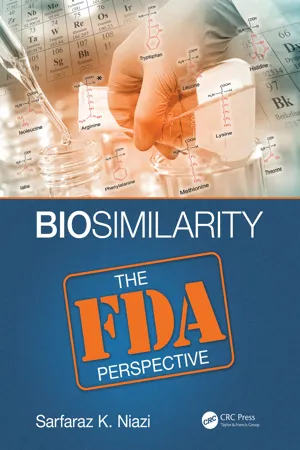1.1Background
Biopharmaceuticals are more complex and have larger molecular weight, variable structure, dynamic protein, and antibody molecules compared to pharmaceutical products wherein a fixed structure is always present. Some prominent examples include cytokines, antibodies, and hormones (Figure 1.1).
Figure 1.1Analytics and process metrics. LMW: Low–molecular weight. (From http://www.fda.gov/downloads/AdvisoryCommittees/CommitteesMeetingMaterials/Drugs/AdvisoryCommitteeforPharmaceuticalScienceandClinicalPharmacology/UCM315764.pdf.)
Cytokines are a broad and loose category of small proteins (~5–20 kDa) that are important in cell signaling. They are released by cells and they affect the behavior of other cells. Cytokines can also be involved in autocrine signaling. Cytokines include chemokines, interferons, interleukins, lymphokines, and tumor necrosis factor (TNF), but generally not hormones or growth factors (despite some terminology overlap). Cytokines are produced by a broad range of cells, including immune cells like macrophages, B lymphocytes, T lymphocytes, and mast cells, as well as endothelial cells, fibroblasts, and various stromal cells; a given cytokine may be produced by more than one type of cell. Cytokines act through receptors and are especially important in the immune system; cytokines modulate the balance between humoral and cell-based immune responses, and they regulate the maturation, growth, and responsiveness of particular cell populations. Some cytokines enhance or inhibit the action of other cytokines in complex ways. They are different from hormones, which are also important cell signaling molecules, in that hormones circulate in much lower concentrations and hormones tend to be made by specific kinds of cells.
An antibody, also known as an immunoglobulin, is a large, Y-shaped protein produced by plasma cells that are used by the immune system to identify and neutralize pathogens such as bacteria and viruses. The antibody recognizes an antigen, via the variable region. Each tip of the Y of an antibody contains a paratope that is specific for one particular epitope (analogous to a key) on an antigen, allowing these two structures to bind together with precision. Using this binding mechanism, an antibody can tag a microbe or an infected cell for attack by other parts of the immune system, or can directly neutralize its target (for example, by blocking a part of a microbe that is essential for its invasion and survival). The ability of an antibody to communicate with the other components of the immune system is mediated via its fragment crystallizable (Fc) region (located at the base of the Y), which contains a conserved glycosylation site involved in these interactions. The production of antibodies is the main function of the humoral immune system.
Although the general structure of all antibodies is very similar, a small region at the tip of the protein is extremely variable, allowing millions of antibodies with slightly different tip structures, or antigen-binding sites, to exist. This region is known as the hypervariable region. Each of these variants can bind to a different antigen. This enormous diversity of antibody paratopes on the antigen-binding fragments allows the immune system to recognize an equally wide variety of antigens.
Hormones are a class of signaling molecules produced by glands in multicellular organisms that are transported by the circulatory system to target distant organs to regulate physiology and behavior. Hormones have diverse chemical structures including eicosanoids, steroids, amino acid derivatives, peptides, and proteins. The glands that secrete hormones include the endocrine signaling system. The term hormone is sometimes extended to include chemicals produced by cells that affect the same cell (autocrine or intracrine signaling) or nearby cells (paracrine signaling).
The protein hormones are synthesized in cells from amino acids according to messenger ribonucleic acid (mRNA) transcripts, which are synthesized from deoxyribonucleic acid (DNA) templates inside the cell nucleus. Preprohormones, peptide hormone precursors, are then processed in several stages, typically in the endoplasmic reticulum, including the removal of the N-terminal signal sequence and sometimes glycosylation, resulting in prohormones. The prohormones are then packaged into membrane-bound secretory vesicles, which can be secreted from the cell by exocytosis in response to specific stimuli (e.g., an increase in Ca2+ and cyclic adenosine monophosphate concentration in the cytoplasm). These prohormones often contain superfluous amino acid residues that were needed to direct the folding of the hormone molecule into its active configuration but have no function once the hormone folds. Specific endopeptidases in...

